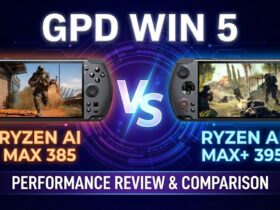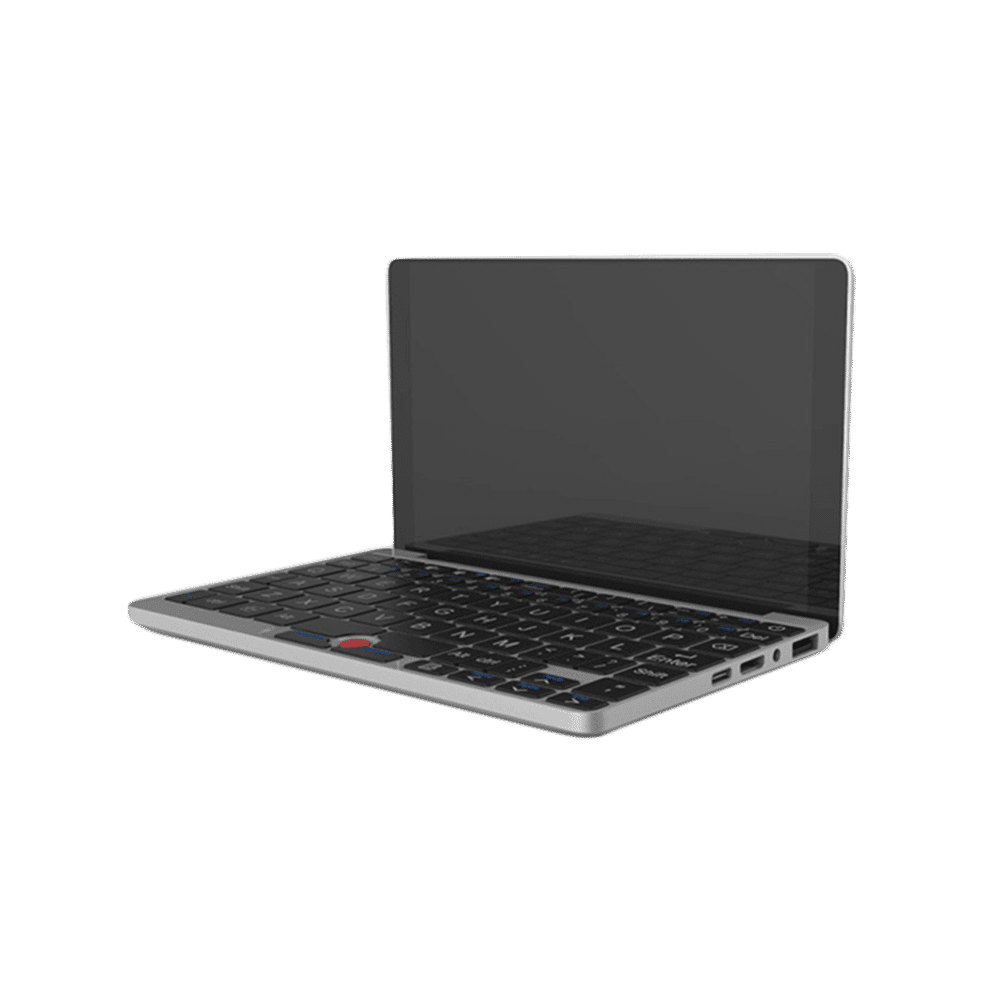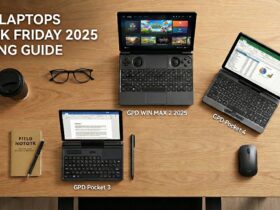Review
-
Build Quality
(4.5)
-
Performance
(4)
-
OS
(5)
Summary
A truly pocket sized PC.
Bendras
4.5Vartotojo apžvalga
( votes)Privalumai
- Exceptional build quality with a sleek design.
- Beautiful IPS touchscreen.
- USB Type-C and port selection is excellent.
Trūkumai
- Typing is difficult on a 7″ PC.
- Niche use for most users.
- Windows 10 on ARM with Qualcomm processors is just around the corner.
Welcome to our GPD Pocket review! If you're interested in a Mini Laptop of your own. You can buy a GPD Pocket here.
GPD Pocket Review Video
In 2006, the concept of Ultra Mobile PCs (UMPC) became a reality with small, inexpensive laptops aimed at the masses. UMPC was a collaboration between Intel and Microsoft to create a new market for peripherals. With touch screens and support for a stylus, UMPC was a precursor to modern smartphones, but without cellular connectivity.
While the concept died in 2010, could 2017 be the right time for such devices to return? GPD is testing the waters with its crowdfunded GPD Pocket, a true handheld running Windows 10.
I've been using the GPD Pocket for a few weeks now and I'm more impressed than expected. While not everything about the GPD Pocket is great because of its size, it's also an incredible feat with exceptional build quality.
About The GPD Pocket
The GPD pouch used for this review was purchased through the Indiegogo campaign that ended in April 2017. The cost of the GPD Pocket was $399, which is the original support price. The suggested retail price for the GPD Pocket is $599, but Aliexpress has it for $499. Since the device has no US distribution, it is available on Amazon for $629. There are no configuration options for GPD Pocket with only one model available, but buyers can choose between a Windows 10 variant or a version with Ubuntu for an operating system.
GPD Pocket Technical Specifications
While GPD may not be a familiar name, the company has already built a few handheld devices, including the GPD Win, a small handheld gaming computer we reviewed in March.
| Category | specification |
|---|---|
| View | 7-inch IPS multi-touch Corning Gorilla Glass 3 |
| Display resolution | 1920 x 1200 323 PPI Aspect 16:10 |
| Software | Windows 10 Home 64-bit |
| Processor | Intel Atom x7-Z8750 @ 1.6 GHz (Turbo 2.56 GHz) |
| Storage space | 128GB eMMC |
| Memory | 8 GB LPDDR3-1600 |
| Graphics | Intel HD Graphics 405 200 MHz base; 600 MHz burst |
| Hello Windows | No |
| Front camera | No |
| Speakers | Realtek ALC5645 Stereo speaker |
| Ports | 1x USB Type-C 3.0 1x USB Type-A 3.0 Type HDMI D 3.5 mm headphone jack |
| Sensors | Gravity sensor, Hall sensor |
| Network | 802.11a / ac / b / g / n, 2,4 / 5 GHz Bluetooth 4.1 |
| Battery | 7 000 mAh Li-Po |
| Battery Lifetime | 12 Hours (Estimated) |
| Weight | 0,48 kg (1,06 lb) |
| Dimensions | 180mm x 106mm x 18.5mm |
| Colours | Silver |
It should come as no surprise that the GPD Pocket packs only an Intel Atom processor. With a base speed of 1.6GHz and a resolution of up to 2.56GHz, it's not very fast compared to an Ultrabook laptop, but it handles Windows 10 just fine, especially for this form factor. While Intel does not support older Atom processors (circa 2012) with Windows 10, the Intel Atom x7-Z8750 processor was only released in Q1 2016 and is supported for later Windows 10 updates.
Impressively, GPD managed to get 8GB of RAM into the Pocket. Even the Surface Pro and Surface Laptop have 4GB models, but GPD opted for a higher configuration.
The rest of the specs may seem mundane, but I'm very impressed with GPD's hardware choices. Whether it's port selection, display or general construction, the company puts a lot of effort, thought and good old-fashioned grease into the pocket expectations.
GPD Pocket build and design
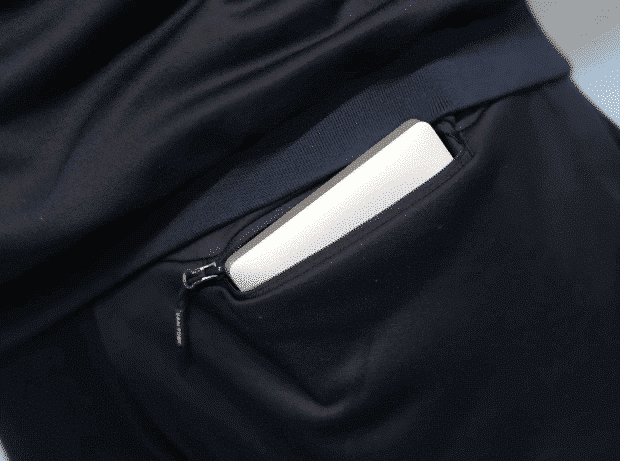
What is striking about the GPD Pocket is how well it fits and works. Constructed from CNC magnesium alloy, the GPD Pocket is a solid, clean and exquisitely made laptop.
GPD has not put any logos or labels on the pocket, giving it a clean look when closed. It is simply a silver shell echoing an old miniature Apple MacBook. On the front is a small notch to open the screen cover. Although you can't open it with one hand, the hinge that supports the 7-inch screen is smooth and sturdy.
At the bottom are rubber feet and a small area for the speaker and intake. There are six hex head screws to open the GPD Pocket, but it contains no upgradeable parts.
There are no creaks, weak spots or impressive feelings about the GPD Pocket. It is a solid magnesium device, precision built, smooth and elegant. I can't say enough about how well-made GPD is for this PC.
GPD Pocket touch screen

The 1900 x 1200 IPS touchscreen of the GPD Pocket is exceptional. Again, exceeding my expectations. With a layer of Corning Gorilla Glass 3 for protection, razor thin edges at the top and bottom and a pleasing 16:10 aspect ratio, the GPD Pocket's display is beautiful.
IPS display technology is used in high-end laptops and desktops and guarantees excellent viewing angles, sharp colours and no opacity. Colour accuracy is high and text is very sharp and easy to read, even if you are still looking at a 7-inch screen as a laptop and not as a smartphone.
With 323 pixels per inch (PPI), the Pocket has a „Retina Level" display quality as GPD calls it.
It's also surprising to find a touchscreen of this calibre in such a device. When I give it to people for the first time, they grab the screen and are pleasantly surprised to find that it's touch-sensitive - and that it works well. Admittedly, the touch targets in Windows 10 on a 7-inch screen are small, but for basic functionality such as scrolling, closing apps or selecting the OK button, it works.
Unfortunately, no active pen is supported, which would have been a cherry on top.
For watching movies, Sling for TV or even playing light video games from Windows 10, the GPD Pocket display is a real hit.
GPD Pocket keyboard and navigation
If you were expecting to pick up the GPD Pocket to unpack papers or write long emails using the built-in keyboard, you would be disappointed.
To be fair, the GPD Pocket's keyboard is well designed and given the size constraints, GPD has done its best. However, at the end of the day you have an excellent keyboard that is about a quarter the size of a standard laptop, which makes typing difficult.
Nevertheless, it's nice to have, and I'm sure some users can make it work. The keys aren't backlit, but they have a surprisingly long travel, which I peg at least at about 1.3mm. Key response is smooth and, even if the keyboard is cluttered, you get a dedicated key for Start, Alt, Ctrl, a power button and function keys for screen brightness, volume etc. I'm not a fan of the smaller backspace key versus the larger delete key, but typing on the GPD Pocket is already a challenge of this size.
For navigation, GPD uses a blue navigation node instead of a trackpad. Below the node are the right and left click keys. Although I don't like nodes on proper laptops, I must admit that I liked the fact that it worked well here - again, given the size constraints.
The good news is that typing is bad and navigation is technically solvable After all, the GPD Pocket is a full PC with some expansion ports. Use a wired USB mouse or just add a Bluetooth keyboard and the typing and navigation experiences suddenly change.
GPD Pocket ports
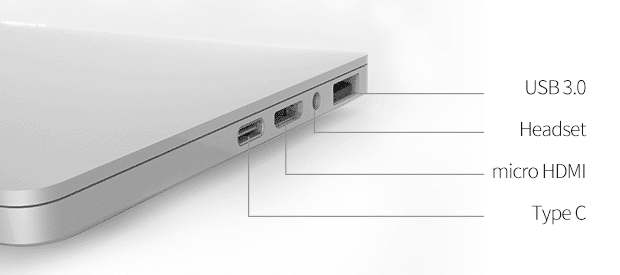
For a PC, this little GPD packs a lot into its input and output (I/O) ports. There are single ports for USB Type-C, USB Type-A and even a micro HDMI display output.
The Type-C port is very welcome as it allows for several expansion perspectives, including a display (4K, 30 FPS; 1080P at 60) while simultaneously charging the device. This port can also be used for data. It should be noted, quite obviously, that the GPD Pocket does not support Thunderbolt 3 for data transfer at 40 Gbps.
With USB Type-A, users of existing peripherals, including mice or USB sticks, will have no problem either.
Combined with Bluetooth 4.1 support and this selection of ports, the GPD Pocket becomes a potentially powerful all-in-one PC with external accessories.
GPD Pocket Audio
Although there are no two front-facing stereo speakers on the GPD Pocket, it does manage with one speaker.
It's not the most impressive sound in a device, small as it is, the audio is good enough to watch a movie, YouTube clip or even listen to music.
The audio is crisp and lacks richness, but it can get quite noisy. The sound seems to resonate upwards through the keyboard, which makes it an elegant model.
I didn't have high hopes for the sound with the GPD Pocket, but it's better than average for this price.
GPD Pocket performance and battery
GPD has managed to squeeze a full laptop into a seven-inch handheld, which is nice. The Intel Atom processor is not exciting, but an Intel Core i5 or i7 would be out of the question. These processors require more space, much more power, higher heat dissipation and cost three times as much as the Intel Atom, making it unfeasible.
However, Windows 10 works quite well with an Intel Atom if you stick to the apps in the Windows Store and that are built into the operating system. It takes about six seconds to launch Twitter or MSN News, including streaming data.
Playing a 1080p video on YouTube at 60 frames per second was no problem at all, without a crush. Combined with this display, it was fantastic too.
I could easily play Pinball FX2 for Windows 10 using an Xbox controller connected to Bluetooth. In fact, it was really nice. For light games like Microsoft Ultimate Word Games and other arcade titles, the 8GB of RAM and Intel Atom processor are just fine.
For storage, the GPD Pocket uses a quality Samsung DJNB4R eMMC instead of an SSD, which would take up too much space. Performance is decent with 146 MB/s read and 88 MB/s write.
The GPD Pocket can get hot - but not warm - under extreme usage conditions.
Unexpectedly, the Intel Atom processor could become very hot. Under heavy load, e.g. when updating a Windows operating system or when playing a video, temperatures could reach 40°C (104°F) from the air outlet. This is not at all hot compared to a full laptop, but it is hotter than your smartphone on a larger surface. During normal use, the temperature is around 32°C (90°F).
GPD has included active cooling with the Pocket. This means that there is a small fan for the exhaust port on the side. The fan is audible when the processor is stretched for play, but under normal operating conditions it is quiet.
Battery estimates are 12 hours with the GPD Pocket, but that's on the high end. I felt I could lose six to eight hours depending on how hard I pushed it. That's pretty good, though, for something that fits in your pocket. Charging is handled by the included USB Type-C charger.
While Intel Atom leaves a lot to be desired for lightweight computing - that's what the GPD Pocket is all about - it's a doable experience buoyed by the quality of the rest of the hardware.
Conclusion: GPD Pocket may be a novelty, but it is impressive
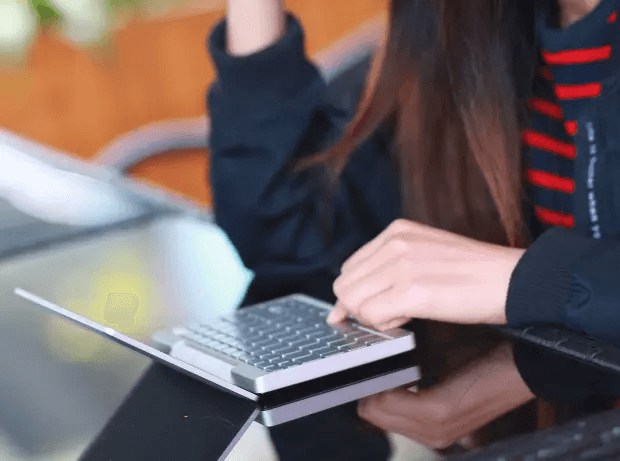
The GPD Pocket can be summed up as an expensive, unique and surprisingly well designed PC that literally fits in your pocket.
Is this a fair value? The $500 price tag doesn't make it a disposable purchase for most people. Besides, you really can't use it as a full computer without a compromise of this size. Typing on a keyboard is possible, but not pleasant, and looking at a seven-inch screen two feet away from you can strain the eyes.
Alternatively, many people could use the GPD Pocket intelligently. Using a handheld on a cramped air flight might be better than taking out a full laptop. The ability to turn the GPD Pocket into a desktop PC by adding a full-size keyboard, mouse and monitor is also not only feasible, but a fun experience. Coupling the GPD Pocket with your smartphone to give it 4G data also makes it more useful for those times when you just need more computing.
I also didn't encounter any major bugs, issues or strange experiences with Windows 10. Everything worked as expected.
The GPD Pocket would be very easy to dismiss if the hardware wasn't so impressive. The 1900 x 1200 screen is outstanding and easily the centrepiece. Audio and typing are not the best are better than expected and the 8GB of RAM makes it a more realistic replacement PC for many.
Still, it's hard to recommend the GPD Pocket unless you only have the money to spare. It's a niche solution to a problem that few people have today. Plus, Microsoft and Qualcomm are about to make Windows 10 on ARM available to everyone. I'd love to see the GPD Pocket 2 use a Qualcomm Snapdragon 835, a bit thinner and add 4G LTE to the mix. This device is starting to make more sense. Whether GPD will adopt such a design remains to be seen, but it is more intriguing than an Intel Atom in 2017.
After all is said and done in this GPD Pocket review, I can't recommend this mini lapotp to the average person. However, power users and enthusiasts with money to spare won't be disappointed. Although specialised, the GPD Pocket is great to use and constantly surprises with its multiple uses. Don't expect it to replace your laptop.
Finally, keep an eye on the GPD. The company is clearly moving into new territory by taking risks, but they also have the courage to make quality hardware. I can't wait to see what they do next.
You can buy a GPD Pocket here and browse our range of Mini Laptop here.





